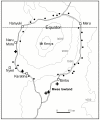New records of Anopheles arabiensis breeding on the Mount Kenya highlands indicate indigenous malaria transmission
- PMID: 16522206
- PMCID: PMC1420308
- DOI: 10.1186/1475-2875-5-17
New records of Anopheles arabiensis breeding on the Mount Kenya highlands indicate indigenous malaria transmission
Abstract
Background: Malaria cases on the highlands west of Mount Kenya have been noticed since 10-20 years ago. It was not clear whether these cases were introduced from the nearby lowland or resulted from local transmission because of no record of vector mosquitoes on the highlands. Determination of presence and abundance of malaria vector is vital for effective control and epidemic risk assessment of malaria among both local residents and tourists.
Methods: A survey on 31 aquatic sites for the malaria-vector mosquitoes was carried out along the primary road on the highlands around Mount Kenya and the nearby Mwea lowland during April 13 to June 28, 2005. Anopheline larvae were collected and reared into adults for morphological and molecular species identification. In addition, 31 families at three locations of the highlands were surveyed using a questionnaire about their history of malaria cases during the past five to 20 years.
Results: Specimens of Anopheles arabiensis were molecularly identified in Karatina and Naro Moru on the highlands at elevations of 1,720-1,921 m above sea level. This species was also the only malaria vector found in the Mwea lowland. Malaria cases were recorded in the two highland locations in the past 10 years with a trend of increasing.
Conclusion: Local malaria transmission on the Mount Kenya highlands is possible due to the presence of An. arabiensis. Land use pattern and land cover might be the key factors affecting the vector population dynamics and the highland malaria transmission in the region.
Figures
References
-
- Breman JG, Egan A, Keusch GT. Intolerable burden of malaria: a new look at the numbers. Am J Trop Med Hyg. 2001;64:4–7. - PubMed
-
- Cox J., Craig M, Sueur DL, Sharp B. Mapping Malaria Risk in the Highlands of Africa. MARA/HIMAL Technical Report. 1999.
-
- Gillies MT, Coetzee M. A Supplement to the Anophelinae of Africa South of the Sahara. Publ S Afr Inst Med Res. 1987;55
-
- Mount Kenya travel info Seasons and precautions http://www.ecoafrica.com/african/travel/MountKenya.html
Publication types
MeSH terms
Grants and funding
LinkOut - more resources
Full Text Sources
Miscellaneous


